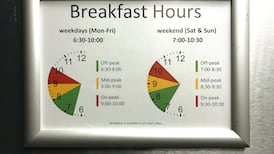As the grandson of immigrants, people who started a new life in Ireland with no family, network or connections, I find it rather odd to hear people talk about the “real Irish” or the “true Irish”. Maybe I don’t qualify? Who knows? But now that everyone’s doing it, let’s talk about immigrants.
The first thing to point out is that there has been a significant spike in the number of people arriving here. According to the Central Statistics Office, last year our population increased by 88,000 people, which is the largest annual increase since 2008, and 120,700 immigrants came into the State, which is a 15-year high.
This large number of immigrants in 2022 was almost double the numbers seen in 2021. In fact, it is the second-largest increase in immigrants over the past 30 years, surpassed only in the boom year of 2007, before the economy derailed. The majority (63,000) of these people came from beyond the borders of the European Union and UK. Up to April 2022, this figure included 28,000 Ukrainians fleeing war. The Ukrainian figure has jumped since then.
In total, immigrants make up around 13.8 per cent (768,900) of the overall population. About one in every seven people walking around Ireland today are immigrants. According to the Fiscal Council, foreigners as a percentage of the total population will rise to 18.2–19.7 per cent by 2051, so roughly one in five.
READ MORE
The false story being told – quite widely, unfortunately – is that these people, immigrants, are scroungers leeching off the rest of us. The reality of migration is different. Immigrants add enormously to economic growth and, over time, their taxes and ingenuity will pay for Irish people’s retirements.
Let’s have a look at some facts.
The most recent arrivals are highly educated, with 70,300 (58.2 per cent) holding a third-level qualification. EU immigrants account for 9.6 per cent of the workforce here, while those born outside the EU account for 4.9 per cent. Now here’s where it gets interesting. Seventy-seven per cent of all immigrants go to work every day, as opposed to just 63 per cent of people born in Ireland. Only 18 per cent of immigrants are not making themselves available for work, as opposed to 24.1 per cent of Irish people.
Despite the fact that Ireland has among the highest percentages of people with third-level qualifications in the EU, the immigrants of working age are even more likely to have a third-level education than their Irish-born counterparts. So Ireland is getting qualified people, whose education has been paid for by someone else’s taxes, not ours. This is an obvious advantage for the country.
Today in Ireland, immigrants from Asia and North America are more likely to occupy professional/managerial class jobs than their Irish counterparts. Interestingly, although immigrants from EU countries find it easier than those from non-EU countries to get a job here, those from outside the EU, when they get a job, are more likely to work in higher-skilled jobs.
Ten years ago, nearly half – 46 per cent – of all the workers here who were not European were employed in what the ESRI describes as “high-skilled occupations”. That figure is likely to have increased. Meanwhile, the National Skills Council maintains that Ireland is short of IT technicians with foreign languages, software developers/engineers and IT analysts/engineers. Where do we think these workers are going to come from?
Already in the ICT sector in Ireland, 34 per cent of workers are non-Irish. Obviously, if we desire a high-wage, high-skill society, we need to have this type of talent; otherwise the opportunities will go elsewhere. By the way, we’ve tried the low-wage, low-skill option in the 1950s and it didn’t look too pretty.
We hear a lot about welfare tourism within the EU, but the facts are that immigrants’ take-up of welfare benefits is actually lower than that of the locally-born population, according to a report put forward by the European Foundation. Of course we can all find examples of immigrants on welfare, but the actual data indicates that “our own” are more likely to be benefiting from social welfare.
Immigrants were also less likely than Irish people to use the health system, either going to the GP or consulting a specialist doctor. According to the Irish Universities Association, there are more than 32,000 international students studying in Ireland and there are also well over 100,000 international students in Ireland studying English. Think about how much they add to the economy every day.
Like my own grandparents, people who come to the country (from Scotland, in their case) without contacts are much more likely to start their own small businesses or be self-employed because, as they say, “it’s not what you know, but who you know”; if you don’t know anyone, the chances are that you have to go out ‘on your tod’.
We know that small businesses can become big businesses. In the United States, 40 per cent of Fortune 500 companies were founded by first- or second-generation immigrants, while 18 per cent of fast-growing tech companies in the UK were created by a foreign-born founder, according to Tech Nation. This figure is about 25 per cent in the US, and a quarter of all US-based Nobel laureates were foreign-born.
These entrepreneurial and talent statistics suggest that host nations often get the best and brightest the world has to offer. Recent studies in the American Economic Association (the holy of holies for economics) highlight that an immigrant in the US is about 80 per cent more likely to found a firm compared with people born in that country. Since 2016, 25 per cent of all Irish start-ups have been founded by foreigners. Immigrants are “job creators” not “job takers”.
Globally, it is estimated that 270 million people in the world today are migrants and their worldwide economic contribution came to about $6.7 trillion. This means that these people, just 3.4 per cent of the world’s global population, contribute about 9.4 per cent of the world’s income.
Obviously the issue of immigration is a huge national debate. Some people are afraid of “the other”; I get that. Strangeness can be discombobulating. Some argue that the country’s infrastructure – particularly housing – can’t handle the strain. I understand that too. However, when it comes to the economy, tax revenue, company formation and the growth rate – which pays for everything – the evidence is overwhelming: to put it crudely, immigrants make a country rich.
In the 1850s, an anti-Irish political movement called the Know-Nothing party emerged in America as a response to the 990,000 Irish who emigrated to the US between 1851 and 1860 – 83 per cent of all immigrants to the US.
We would do well to remember that.












